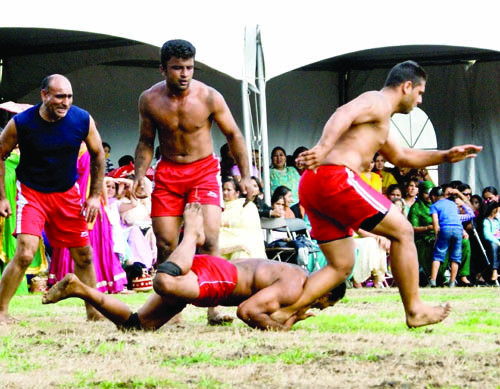Kabaddi Your Body
Ancient Indian Sport Takes Tournament to LaSalle
The wind silently blows sand off the turf as a barefooted, bare-chested and well-built man with arms spread wide, crouched low to the ground, faces four players of the opposing team in fierce competition.
The supple player, called the raider, peers into the eyes of the four defenders, commonly referred to as stoppers. His challenge is to touch one of his four opponents and score a point by returning to his base. It sounds like a game of tag at first, however the real test begins when one of the four stoppers, once touched or tagged, attempts to stop the raider in any way possible.
The raider feints to the right, then swipes at the far left stopper, who leaps back, avoiding the tag. Simultaneously, the centre stopper leaps forward and tackles the raider at the knees. They struggle, but this time the raider breaks free and hastily retreats. The stopper continues to give chase—to no avail as the raider returns to his base.
The point goes to the raider’s team, who will now defend against the opposing team’s arriving raider.
To an unknown bystander, the 4,000-year-old game of Kabaddi would appear to be more of a rural fight between men rather than a sport. A simple yet demanding game, Kabaddi has been played for thousands of years by rural Southeastern Asians, especially in the Punjab—a Northwestern state of India—where it is considered the official state sport. The game’s popularity in rural India can be explained by the relative simplicity of the rules and to the fact that it requires no expensive or sophisticated equipment.
Kabaddi is played all over Asia with minor variations.
The two teams battle for the higher score, alternating defence and offence. Consisting of two 20-minute halves, the team winning the initial coin toss sends a raider into the opponent’s half, where his aim is to touch one of the stoppers on the opposing side and return to his court within 30 seconds of entering the half.
The stopper, whom the raider touches, will then attempt to stall and impede the raider from returning to his side of the court within the 30 seconds. If the raider cannot return to his court within the time limit, the point is awarded to the stopper’s team.
Each team alternates in sending a player into the opponent’s court. If a player goes out of bounds during the course of the play or if any part of his body touches the ground outside the boundary, he will be ruled out and give up the point to the opposing team.
On July 24 and 25, a Kabaddi tournament was organized by various Indo-Canadian and Punjabi-Canadian Organizations in LaSalle to promote the sport in Quebec.
Along with Kabaddi, soccer, volleyball and track and field competitions were also organized for younger children to encourage athletic involvement as part of healthier lifestyles.
Kabaddi brings to mind childhood memories for Malwinder Chahal, one of the spectators at this event.
“I’ve been here [in Montreal] over 30 years. When my children watch the Canadiens’ [hockey] matches, I tell them, when we were little in India, this is the sport we used to watch,” he said.
The tournament was hailed as a great success by the organizers, as an estimated 800 people were present to watch the matches unfold. Teams from across Montreal, Ontario and California were present and a first place prize of $10,000 was awarded to the Kesri Punjab Club—an international Kabaddi club originating from Punjab, India.
People of all ages, mostly tandems of fathers and sons, as well as groups of younger men, sat in the stands to watch the action. Like in any sport, the more passionate fans on hand debated the ongoing match and sometimes protested calls made by the referee.
“[About] 99.9 per cent of the people watching are men,” explained one of the organizers of the tournament. “It is a ‘man’s game’ with a lot [of] physical action. Girls for some reason don’t come in large numbers. It is like wrestling, you know?”
Kabaddi is not limited to only men, though. In India, there are a growing number of female teams.
“It’s a tough, tough sport,” said Manjeet Aulakh, a younger player from the under-21 side. “You have to play almost nonstop [for 20 minutes in] each half and the pace is relentless.”
That seemed all the more evident as many players sported bandages and braces around their ankles, knees and shoulders, to protect injuries garnered mostly from past battles.
“But I still love it,” continued Aulakh.” Just the tradition behind the game means so much to me and my family. I love this sport.”
This article originally appeared in Volume 31, Issue 02, published August 24, 2010.



__600_375_90_s_c1.jpg)
_600_375_90_s_c1.jpg)
1_600_375_90_s_c1.jpg)
1_600_375_90_s_c1.jpg)